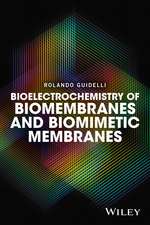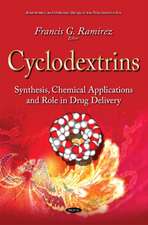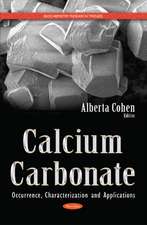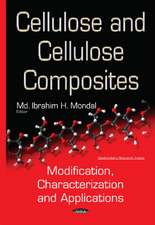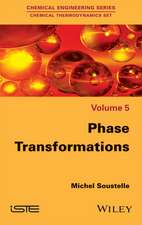Chemotaxis: Methods and Protocols: Methods in Molecular Biology, cartea 1407
Editat de Tian Jin, Dale Herelden Limba Engleză Hardback – 7 iun 2016
Cutting edge and thorough,Chemotaxis: Methods and Protocols, Second Edition is a valuable resource foranyone who is interested in the diverse methodologies that are propellingchemotaxis research forward.
| Toate formatele și edițiile | Preț | Express |
|---|---|---|
| Paperback (2) | 615.05 lei 38-45 zile | |
| Humana Press Inc. – 7 mar 2012 | 615.05 lei 38-45 zile | |
| Springer – 26 mai 2018 | 787.57 lei 6-8 săpt. | |
| Hardback (2) | 660.49 lei 6-8 săpt. | |
| Springer – 7 iun 2016 | 660.49 lei 6-8 săpt. | |
| Humana Press Inc. – 25 sep 2009 | 836.67 lei 38-45 zile |
Din seria Methods in Molecular Biology
- 9%
 Preț: 791.59 lei
Preț: 791.59 lei - 23%
 Preț: 598.56 lei
Preț: 598.56 lei -
 Preț: 496.79 lei
Preț: 496.79 lei - 20%
 Preț: 882.95 lei
Preț: 882.95 lei -
 Preț: 252.04 lei
Preț: 252.04 lei - 5%
 Preț: 729.61 lei
Preț: 729.61 lei - 5%
 Preț: 731.43 lei
Preț: 731.43 lei - 5%
 Preț: 741.30 lei
Preț: 741.30 lei - 5%
 Preț: 747.16 lei
Preț: 747.16 lei - 15%
 Preț: 663.45 lei
Preț: 663.45 lei - 18%
 Preț: 1025.34 lei
Preț: 1025.34 lei - 5%
 Preț: 734.57 lei
Preț: 734.57 lei - 18%
 Preț: 914.20 lei
Preț: 914.20 lei - 15%
 Preț: 664.61 lei
Preț: 664.61 lei - 15%
 Preț: 654.12 lei
Preț: 654.12 lei - 18%
 Preț: 1414.74 lei
Preț: 1414.74 lei - 5%
 Preț: 742.60 lei
Preț: 742.60 lei - 20%
 Preț: 821.63 lei
Preț: 821.63 lei - 18%
 Preț: 972.30 lei
Preț: 972.30 lei - 15%
 Preț: 660.49 lei
Preț: 660.49 lei - 5%
 Preț: 738.41 lei
Preț: 738.41 lei - 18%
 Preț: 984.92 lei
Preț: 984.92 lei - 5%
 Preț: 733.29 lei
Preț: 733.29 lei -
 Preț: 392.58 lei
Preț: 392.58 lei - 5%
 Preț: 746.26 lei
Preț: 746.26 lei - 18%
 Preț: 962.66 lei
Preț: 962.66 lei - 23%
 Preț: 860.21 lei
Preț: 860.21 lei - 15%
 Preț: 652.64 lei
Preț: 652.64 lei - 5%
 Preț: 1055.50 lei
Preț: 1055.50 lei - 23%
 Preț: 883.85 lei
Preț: 883.85 lei -
 Preț: 792.16 lei
Preț: 792.16 lei -
 Preț: 423.62 lei
Preț: 423.62 lei - 5%
 Preț: 425.91 lei
Preț: 425.91 lei -
 Preț: 592.20 lei
Preț: 592.20 lei - 5%
 Preț: 345.62 lei
Preț: 345.62 lei - 19%
 Preț: 491.88 lei
Preț: 491.88 lei - 5%
 Preț: 1038.84 lei
Preț: 1038.84 lei - 5%
 Preț: 524.15 lei
Preț: 524.15 lei - 18%
 Preț: 2122.34 lei
Preț: 2122.34 lei - 5%
 Preț: 1299.23 lei
Preț: 1299.23 lei -
 Preț: 789.93 lei
Preț: 789.93 lei - 5%
 Preț: 1339.10 lei
Preț: 1339.10 lei - 18%
 Preț: 1390.26 lei
Preț: 1390.26 lei - 5%
 Preț: 752.66 lei
Preț: 752.66 lei - 5%
 Preț: 374.89 lei
Preț: 374.89 lei - 18%
 Preț: 1395.63 lei
Preț: 1395.63 lei - 18%
 Preț: 1129.65 lei
Preț: 1129.65 lei - 18%
 Preț: 1408.26 lei
Preț: 1408.26 lei - 18%
 Preț: 1124.92 lei
Preț: 1124.92 lei - 18%
 Preț: 966.27 lei
Preț: 966.27 lei
Preț: 660.49 lei
Preț vechi: 777.05 lei
-15% Nou
Puncte Express: 991
Preț estimativ în valută:
126.41€ • 131.62$ • 106.83£
126.41€ • 131.62$ • 106.83£
Carte tipărită la comandă
Livrare economică 07-21 martie
Preluare comenzi: 021 569.72.76
Specificații
ISBN-13: 9781493934782
ISBN-10: 1493934783
Pagini: 420
Ilustrații: XIV, 425 p. 118 illus., 83 illus. in color.
Dimensiuni: 178 x 254 x 25 mm
Greutate: 0.98 kg
Ediția:2nd ed. 2016
Editura: Springer
Colecția Humana
Seria Methods in Molecular Biology
Locul publicării:New York, NY, United States
ISBN-10: 1493934783
Pagini: 420
Ilustrații: XIV, 425 p. 118 illus., 83 illus. in color.
Dimensiuni: 178 x 254 x 25 mm
Greutate: 0.98 kg
Ediția:2nd ed. 2016
Editura: Springer
Colecția Humana
Seria Methods in Molecular Biology
Locul publicării:New York, NY, United States
Public țintă
Professional/practitionerCuprins
In Situ Assays of Chemotropism duringYeast Mating.- ImagingPolarization in Budding Yeast Migration of Dictyostelium discoideum to theChemoattractant Folic Acid.- MitochondrialStress Tests Using Seahorse Respirometry on Intact Dictyostelium discoideum Cells.- StudyingChemoattractant Signal Transduction Dynamics in Dictyostelium by BRET.- Wave Patternsin Cell Membrane and Actin Cortex Uncoupled from Chemotactic Signals.- ChemotacticBlebbing in Dictyostelium Cells.- DissectingSpatial and Temporal Sensing in DictyosteliumChemotaxis Using a Wave Gradient Generator.- Employing Dictyostelium as an Advantageous 3RsModel for Pharmacogenetic Research.- Identificationof Associated Proteins by Immunoprecipitation and Mass Spectrometry Analysis.- BiochemicalResponses to Chemically Distinct Chemoattractants during the Growth andDevelopment of Dictyostelium.- Live Imaging ofBorder Cell Migrationin Drosophila.- ShRNA-InducedGene Knock-Down In Vivo to Investigate Neutrophil Function.- StudyingNeutrophil Migration In Vivo Using Adoptive Cell Transfer.- IntravitalTwo-Photon Imaging of Lymphocytes Crossing High Endothelial Venules andCortical Lymphatics in the Inguinal Lymph Node.- FlowCytometry-Based Quantification of HIV-Induced T Cell Chemotactic Response.- VisualizingCancer Cell Chemotaxis and Invasion in 2D and 3D.- 4D TumorigenesisModel for Quantitating Coalescence, Directed Cell Motility and Chemotaxis,Identifying Unique Cell Behaviors and Testing Anti-Cancer Drugs.- An ExperimentalModel for Simultaneous Study of Migration of Cell Fragments, Single Cells andCell Sheets.- Axon GuidanceStudies Using a Microfluidics-Based Chemotropic Gradient Generator.- Visualization ofActin Assembly and Filament Turnover by In Vitro Multi-Color TIRF Microscopy.- QuantitativeMonitoring Spatiotemporal Activation of Ras and PKD1 Using Confocal FluorescentMicroscopy.- FluorescenceReadout of a Patch Clamped Membrane by Laser Scanning Microscopy.- Use of ResonanceEnergy Transfer Techniques for In Vivo Detection of Chemokine ReceptorOligomerization.- Multi-StateTransition Kinetics of Intracellular Signaling Molecules by Single-MoleculeImaging Analysis.- Mathematics ofExperimentally Generated Chemoattractant Gradients.- ModelingExcitable Dynamics of Chemotactic Networks.
Textul de pe ultima copertă
This second edition expands on the first edition with new chapters describing methods for studying cell movement, molecular components involved in chemotaxis, spatiotemporal dynamics of signaling components, and quantitative modeling, as well as several updated chapters from the first edition. Various methods to investigate directional cell growth and movements are presented in Chapters 1-20. These chapters contains experimental procedures to visualize and measure migration behaviors of different kinds of organisms, including chemotropism in the budding yeast; cell growth and migration of D. discoideum; border cell migration in Drosophila; chemotaxis of mouse and human neutrophils; and HIV-induced T cell chemotactic response.Chemotaxis: Methods and Protocols, Second Edition also contains microscopy procedures for studying breast cancer cell migration, tumor cell invasion in vivo, and axon guidance. The book concludes with Chapters 21-27 describing methods that measure spatiotemporal dynamics of signaling components involved in chemotaxis; introduce imaging techniques, such as TRIF, BRET, FRET, and single-molecule microscopy; and mathematical models of experimentally generated chemoattractant gradients. Written in the highly successful Methods in Molecular Biology series format, chapters include introductions to their respective topics, lists of the necessary materials and reagents, step-by-step, readily reproducible laboratory protocols, and tips on troubleshooting and avoiding known pitfalls.
Cutting edge and thorough, Chemotaxis: Methods and Protocols, Second Edition is a valuable resource for anyone who is interested in the diverse methodologies that are propelling chemotaxis research forward.
Cutting edge and thorough, Chemotaxis: Methods and Protocols, Second Edition is a valuable resource for anyone who is interested in the diverse methodologies that are propelling chemotaxis research forward.
Caracteristici
Includes cutting-edge methods and protocols Provides step-by-step detail essential for reproducible results Contains key notes and implementation advice from the experts
Recenzii
From the reviews:“The purpose is to provide an overview of and practical guidance on the diverse methodologies involved in chemotaxis research. … Each chapter includes an introduction to the topic, lists of necessary materials and reagents, laboratory protocol, and notes on troubleshooting and avoiding pitfalls, followed by current references. … This will serve as a valuable resource for students and scientists seeking practical guidance on diverse methodologies in chemotaxis research.” (Omer Iqbal, Doody’s Review Service, April, 2010)



